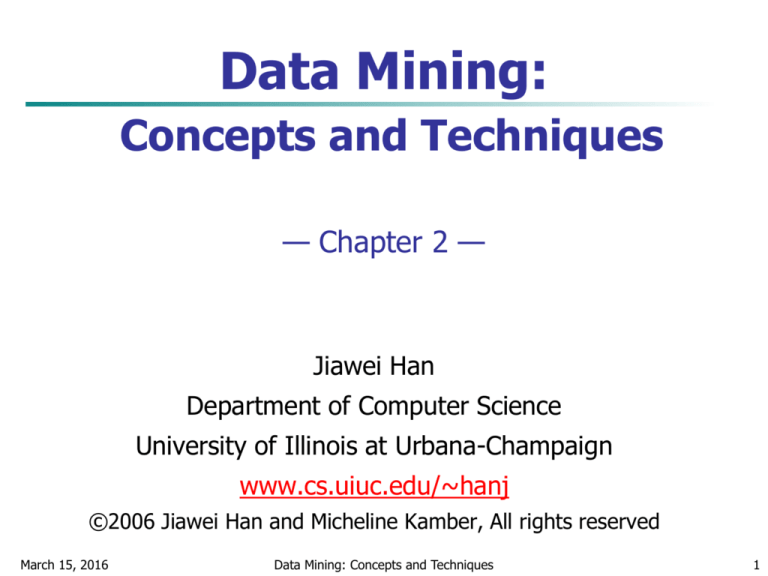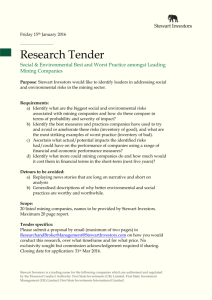
Data Mining:
Concepts and Techniques
— Chapter 2 —
Jiawei Han
Department of Computer Science
University of Illinois at Urbana-Champaign
www.cs.uiuc.edu/~hanj
©2006 Jiawei Han and Micheline Kamber, All rights reserved
March 15, 2016
Data Mining: Concepts and Techniques
1
Chapter 2: Data Preprocessing
Why preprocess the data?
Descriptive data summarization
Data cleaning
Data integration and transformation
Data reduction
Discretization and concept hierarchy generation
Summary
March 15, 2016
Data Mining: Concepts and Techniques
2
Why Data Preprocessing?
Data in the real world is dirty
incomplete: lacking attribute values, lacking
certain attributes of interest, or containing
only aggregate data
noisy: containing errors or outliers
e.g., Salary=“-10”
inconsistent: containing discrepancies in codes
or names
March 15, 2016
e.g., occupation=“ ”
e.g., Age=“42” Birthday=“03/07/1997”
e.g., Was rating “1,2,3”, now rating “A, B, C”
e.g., discrepancy between duplicate records
Data Mining: Concepts and Techniques
3
Why Is Data Dirty?
Incomplete data may come from
Noisy data (incorrect values) may come from
Faulty data collection instruments
Human or computer error at data entry
Errors in data transmission
Inconsistent data may come from
“Not applicable” data value when collected
Different considerations between the time when the data was
collected and when it is analyzed.
Human/hardware/software problems
Different data sources
Functional dependency violation (e.g., modify some linked data)
Duplicate records also need data cleaning
March 15, 2016
Data Mining: Concepts and Techniques
4
Why Is Data Preprocessing Important?
No quality data, no quality mining results!
Quality decisions must be based on quality data
e.g., duplicate or missing data may cause incorrect or even
misleading statistics.
Data warehouse needs consistent integration of quality
data
Data extraction, cleaning, and transformation comprises
the majority of the work of building a data warehouse
March 15, 2016
Data Mining: Concepts and Techniques
5
Multi-Dimensional Measure of Data Quality
A well-accepted multidimensional view:
Accuracy
Completeness
Consistency
Timeliness
Believability
Value added
Interpretability
Accessibility
Broad categories:
Intrinsic, contextual, representational, and accessibility
March 15, 2016
Data Mining: Concepts and Techniques
6
Major Tasks in Data Preprocessing
Data cleaning
Data integration
Normalization and aggregation
Data reduction
Integration of multiple databases, data cubes, or files
Data transformation
Fill in missing values, smooth noisy data, identify or remove
outliers, and resolve inconsistencies
Obtains reduced representation in volume but produces the same
or similar analytical results
Data discretization
Part of data reduction but with particular importance, especially
for numerical data
March 15, 2016
Data Mining: Concepts and Techniques
7
Forms of Data Preprocessing
March 15, 2016
Data Mining: Concepts and Techniques
8
Chapter 2: Data Preprocessing
Why preprocess the data?
Descriptive data summarization
Data cleaning
Data integration and transformation
Data reduction
Discretization and concept hierarchy generation
Summary
March 15, 2016
Data Mining: Concepts and Techniques
9
Mining Data Descriptive Characteristics
Motivation
Data dispersion characteristics
To better understand the data: central tendency, variation
and spread
median, max, min, quantiles, outliers, variance, etc.
Numerical dimensions correspond to sorted intervals
Data dispersion: analyzed with multiple granularities of
precision
Boxplot or quantile analysis on sorted intervals
Dispersion analysis on computed measures
Folding measures into numerical dimensions
Boxplot or quantile analysis on the transformed cube
March 15, 2016
Data Mining: Concepts and Techniques
10
Measuring the Central Tendency
1 n
Mean (algebraic measure) (sample vs. population): x
xi
n i 1
Weighted arithmetic mean:
x
N
n
Trimmed mean: chopping extreme values
x
Median: A holistic measure
w x
i 1
n
i
i
w
i 1
i
Middle value if odd number of values, or average of the middle two
values otherwise
Estimated by interpolation (for grouped data):
median L1 (
Mode
Value that occurs most frequently in the data
Unimodal, bimodal, trimodal
Empirical formula:
March 15, 2016
n / 2 ( f )l
f median
)c
mean mode 3 (mean median)
Data Mining: Concepts and Techniques
11
Symmetric vs. Skewed Data
Median, mean and mode of
symmetric, positively and
negatively skewed data
March 15, 2016
Data Mining: Concepts and Techniques
12
Measuring the Dispersion of Data
Quartiles, outliers and boxplots
Quartiles: Q1 (25th percentile), Q3 (75th percentile)
Inter-quartile range: IQR = Q3 – Q1
Five number summary: min, Q1, M, Q3, max
Boxplot: ends of the box are the quartiles, median is marked, whiskers, and
plot outlier individually
Outlier: usually, a value higher/lower than 1.5 x IQR
Variance and standard deviation (sample: s, population: σ)
Variance: (algebraic, scalable computation)
1 n
1 n 2 1 n
2
s
( xi x )
[ xi ( xi ) 2 ]
n 1 i 1
n 1 i 1
n i 1
2
1
N
2
n
1
(
x
)
i
N
i 1
2
n
xi 2
2
i 1
Standard deviation s (or σ) is the square root of variance s2 (or σ2)
March 15, 2016
Data Mining: Concepts and Techniques
13
Properties of Normal Distribution Curve
The normal (distribution) curve
From μ–σ to μ+σ: contains about 68% of the
measurements (μ: mean, σ: standard deviation)
From μ–2σ to μ+2σ: contains about 95% of it
From μ–3σ to μ+3σ: contains about 99.7% of it
March 15, 2016
Data Mining: Concepts and Techniques
14
Boxplot Analysis
Five-number summary of a distribution:
Minimum, Q1, M, Q3, Maximum
Boxplot
Data is represented with a box
The ends of the box are at the first and third
quartiles, i.e., the height of the box is IRQ
The median is marked by a line within the box
Whiskers: two lines outside the box extend to
Minimum and Maximum
March 15, 2016
Data Mining: Concepts and Techniques
15
Visualization of Data Dispersion: Boxplot Analysis
March 15, 2016
Data Mining: Concepts and Techniques
16
Histogram Analysis
Graph displays of basic statistical class descriptions
Frequency histograms
March 15, 2016
A univariate graphical method
Consists of a set of rectangles that reflect the counts or
frequencies of the classes present in the given data
Data Mining: Concepts and Techniques
17
Quantile Plot
Displays all of the data (allowing the user to assess both
the overall behavior and unusual occurrences)
Plots quantile information
For a data xi data sorted in increasing order, fi
indicates that approximately 100 fi% of the data are
below or equal to the value xi
March 15, 2016
Data Mining: Concepts and Techniques
18
Quantile-Quantile (Q-Q) Plot
Graphs the quantiles of one univariate distribution against
the corresponding quantiles of another
Allows the user to view whether there is a shift in going
from one distribution to another
March 15, 2016
Data Mining: Concepts and Techniques
19
Scatter plot
Provides a first look at bivariate data to see clusters of
points, outliers, etc
Each pair of values is treated as a pair of coordinates and
plotted as points in the plane
March 15, 2016
Data Mining: Concepts and Techniques
20
Loess Curve
Adds a smooth curve to a scatter plot in order to
provide better perception of the pattern of dependence
Loess curve is fitted by setting two parameters: a
smoothing parameter, and the degree of the
polynomials that are fitted by the regression
March 15, 2016
Data Mining: Concepts and Techniques
21
Positively and Negatively Correlated Data
March 15, 2016
Data Mining: Concepts and Techniques
22
Not Correlated Data
March 15, 2016
Data Mining: Concepts and Techniques
23
Graphic Displays of Basic Statistical Descriptions
Histogram: (shown before)
Boxplot: (covered before)
Quantile plot: each value xi is paired with fi indicating
that approximately 100 fi % of data are xi
Quantile-quantile (q-q) plot: graphs the quantiles of one
univariant distribution against the corresponding quantiles
of another
Scatter plot: each pair of values is a pair of coordinates
and plotted as points in the plane
Loess (local regression) curve: add a smooth curve to a
scatter plot to provide better perception of the pattern of
dependence
March 15, 2016
Data Mining: Concepts and Techniques
24






